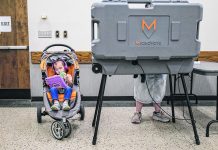WASHINGTON — The Centers for Disease Control and Prevention reversed course Tuesday on some masking guidelines, recommending that vaccinated people return to wearing masks indoors in parts of the U.S. where the coronavirus is surging.
Citing new information about the ability of the delta variant to spread among vaccinated people, the CDC also recommended indoor masks for all teachers, staff, students and visitors to schools, regardless of vaccination status.
In a news briefing Tuesday, CDC Director Dr. Rochelle Walensky said fully vaccinated people in areas of the country with “substantial and high transmission” should wear masks in public indoor settings.
Walensky defined substantial transmission as any place that records 50 to 100 cases per 100,000 people over the previous seven days. Places with more than 100 cases per 100,000 over a seven-day period are classified as having high transmission.
Walensky said the CDC tracks COVID-19 transmission by county using that set of criteria and publishes the data online.
As of Sunday, Bartholomew County was listed as having moderate transmission, one notch below substantial spread, CDC records show.
However, Jackson County was listed as having substantial spread, and Jennings County had high spread, making both of those counties potentially subject to the updated CDC guidance.
As of Tuesday, Bartholomew County was listed as having 25 cases of COVID-19 per 100,000 residents over the past seven days, state records show.
The new guidance came as Indiana reported more than 1,000 COVID-19 cases in one day for the first time in weeks and statewide hospitalizations rose to their highest levels since late May, according to state records.
BCSC Communications Coordinator Josh Burnett said the school corporation is aware of the CDC’s most recent changes in its recommendation to encourage masking indoors.
“As with each CDC update regarding COVID-19, BCSC leadership will continue to review the information and consult with the Bartholomew County Health Department,” he said.
BCSC’s current reopening plan states masks are optional for both staff and students and recommended “for those at risk and/or not vaccinated.” The plan adds that due to a continuing federal mandate, masks are still required on buses.
The Flat Rock-Hawcreek School Corp.’s draft reopening plan also makes masks optional except on buses due to the present mandate. Students and staff must wear masks when visiting the health office.
Superintendent Shawn Price said discussion is ongoing as the Flat Rock-Hawcreek reviews the new guidance.
The first day of school for Flat Rock-Hawcreek is Aug. 5; BCSC students return Aug. 6.
The CDC recommendations come after recent decisions in Los Angeles and St. Louis to revert to indoor mask mandates amid a spike in COVID-19 cases and hospitalizations that have been especially bad in the South, The Associated Press reported. The country is averaging more than 57,000 cases a day and 24,000 COVID-19 hospitalizations.
Most new infections in the U.S. continue to be among unvaccinated people. But “breakthrough” infections, which generally cause milder illness, can occur in vaccinated people. When earlier strains of the virus predominated, infected vaccinated people were found to have low levels of virus and were deemed unlikely to spread the virus much, Walensky said.
But with the delta variant, the level of virus in infected vaccinated people is “indistinguishable” from the level of virus in the noses and throats of unvaccinated people, Walensky said.
The data emerged over the last couple of days from 100 samples. It is unpublished, and the CDC has not released it. But “it is concerning enough that we feel like we have to act,” Walensky said. Vaccinated people “have the potential to spread that virus to others,” she said.
For much of the pandemic, the CDC advised Americans to wear masks outdoors if they were within 6 feet of one another.
Then in April, as vaccination rates rose sharply, the agency eased its guidelines on the wearing of masks outdoors, saying that fully vaccinated Americans no longer needed to cover their faces unless they were in a big crowd of strangers. In May, the guidance was eased further for fully vaccinated people, allowing them to stop wearing masks outdoors in crowds and in most indoor settings.
The guidance still called for wearing masks in crowded indoor settings, like buses, planes, hospitals, prisons and homeless shelters, but it cleared the way for reopening workplaces and other venues.
Subsequent CDC guidance said fully vaccinated people no longer needed to wear masks at summer camps or at schools.
For months COVID cases, deaths and hospitalizations were falling steadily, but those trends began to change at the beginning of the summer as the delta variant, a mutated and more transmissible version of the virus, began to spread widely, especially in areas with lower vaccination rates.
White House press secretary Jen Psaki said the delta variant has changed the nation’s COVID-19 outlook since the the CDC relaxed masking recommendations.
“That is their job. Their job is to look at evolving information, evolving data, an evolving historic pandemic and provide guidance to the American public,” Psaki said.
“What has not changed,” she added, “is the fact that people who are vaccinated have a huge deal of protection from serious illness, from hospitalization and from death.”




